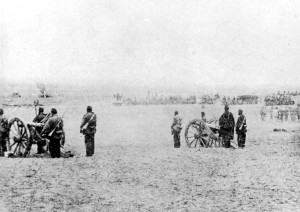 The War of the Triple Alliance, often called the Great War, or the Paraguayan War, was fought at a great cost. No other war in South America’s history has ever resulted in as many deaths. Paraguay fought against the allied countries of Brazil, Argentina and Uruguay from 1864 until 1870.
The War of the Triple Alliance, often called the Great War, or the Paraguayan War, was fought at a great cost. No other war in South America’s history has ever resulted in as many deaths. Paraguay fought against the allied countries of Brazil, Argentina and Uruguay from 1864 until 1870.
The war began over various issues between the four countries. Paraguay had spent years going through boundary and tariff disputes with both Brazil and Argentina. Politics, economic interests, ambitions and even a constant power struggle over the Rio de la Plata region all contributed to the war.
Paraguay was utterly defeated in the war and it took the country decades to overcome the chaos. One estimate places the countries losses from both disease and war at around 1.2 million people, a staggering 90 percent of the entire population. However, another estimate placed the death toll at about 300,000 people.
It’s been argued that the Triple Alliance War played a part in Argentina’s consolidation as a nation-state. It soon became the second wealthiest country in Latin America, only behind Brazil. Uruguay profited from the war in the fact that it would be the last time that Argentina and Brazil would take a drastic interventionist role in the countries internal politics.
The war had helped bring about the abolishment of slavery in Brazil. It had boosted the military into key roles in the public sphere. But, it had also created an enormous amount of public debt, which took the country several decades to repay. This debt seriously reduced growth for Brazil.
Historians have said that when the war first began, the Triple Alliance’s military force was far inferior to Paraguay’s. It’s been believed that Paraguay had over 60,000 men that were well trained. That Paraguay’s naval squadron consisted of 23 steamboats and five ships that could navigate the river. And, that the naval forces were based around a gunboat that featured 400 cannons.
However, more recent studies have revealed an entirely different scenario. While the Paraguayan military did have from 70,000 to 100,000 men, they were more likely very poorly equipped and had very little, if any training. There was no system of command since all the decisions were made by President Lopez. Food, medical care and weapons were scarce. And, what weapons were available, were crude and inaccurate.
In contrast, Uruguay started the war with no navy and less than 2,000 men. Argentina’s naval resources included five ships and about 8,500 men. And, at the beginning of the war, many of the 16,000 troops Brazil had were based at the southern garrisons.
Brazil’s biggest advantage was it’s naval force. The country had 42 ships that were equipped with 239 cannons and a naval crew of around 4,000 men that were well trained. However, Brazil was still totally unprepared for a war. It’s military was unorganized and were mostly volunteers and not professional soldiers.
Although the number of Paraguayan men that died in the war is highly debated, it is known that it was a big percentage of the male population. But, many of the deaths weren’t due to the battles themselves. The lack of fresh food and sanitary water contributed largely to the death toll. It’s been said that cholera was probably the largest cause of death.
A secret clause that was added to the Triple Alliance Treaty ceded a large portion of the Gran Chaco to Argentina. And, after Paraguay’s defeat, Argentina negotiated a proposal with Brazil to split the country in two and enlarge their own countries.
However, Brazil didn’t want to eradicate the country, it served as a divider between Argentina and the Brazilian Empire. A stand off resulted and the Brazilian military remained in the Paraguay territory for 6 years after the war ended to deter any attempted take over from Argentina.

{ 0 comments… add one now }